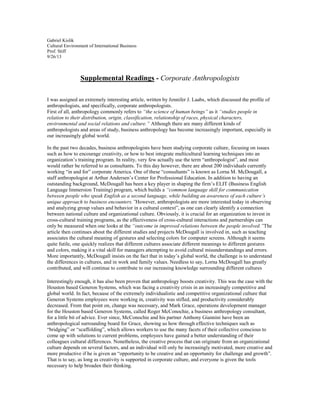Individual presentation 1
- 1. Gabriel Kislik Cultural Environment of International Business Prof. Stiff 9/26/13 Supplemental Readings - Corporate Anthropologists I was assigned an extremely interesting article, written by Jennifer J. Laabs, which discussed the profile of anthropologists, and specifically, corporate anthropologists. First of all, anthropology commonly refers to “the science of human beings” as it “studies people in relation to their distribution, origin, classification, relationship of races, physical characters, environmental and social relations and culture.” Although there are many different kinds of anthropologists and areas of study, business anthropology has become increasingly important, especially in our increasingly global world. In the past two decades, business anthropologists have been studying corporate culture, focusing on issues such as how to encourage creativity, or how to best integrate multicultural learning techniques into an organization’s training program. In reality, very few actually use the term “anthropologist”, and most would rather be referred to as consultants. To this day however, there are about 200 individuals currently working “in and for” corporate America. One of these “consultants” is known as Lorna M. McDougall, a staff anthropologist at Arthur Andersen’s Center for Professional Education. In addition to having an outstanding background, McDougall has been a key player in shaping the firm’s ELIT (Business English Language Immersion Training) program, which builds a “common language skill for communication between people who speak English as a second language, while building an awareness of each culture’s unique approach to business encounters.”However, anthropologists are more interested today in observing and analyzing group values and behavior in a cultural context”, as one can clearly identify a connection between national culture and organizational culture. Obviously, it is crucial for an organization to invest in cross-cultural training programs, as the effectiveness of cross-cultural interactions and partnerships can only be measured when one looks at the “outcome in improved relations between the people involved.”The article then continues about the different studies and projects McDougall is involved in, such as teaching associates the cultural meaning of gestures and selecting colors for computer screens. Although it seems quite futile, one quickly realizes that different cultures associate different meanings to different gestures and colors, making it a vital skill for managers attempting to avoid cultural misunderstandings and errors. More importantly, McDougall insists on the fact that in today’s global world, the challenge is to understand the differences in cultures, and in work and family values. Needless to say, Lorna McDougall has greatly contributed, and will continue to contribute to our increasing knowledge surrounding different cultures Interestingly enough, it has also been proven that anthropology boosts creativity. This was the case with the Houston based Generon Systems, which was facing a creativity crisis in an increasingly competitive and global world. In fact, because of the extremely individualistic and competitive organizational culture that Generon Systems employees were working in, creativity was stifled, and productivity considerably decreased. From that point on, change was necessary, and Mark Grace, operations development manager for the Houston based Generon Systems, called Roger McConochie, a business anthropology consultant, for a little bit of advice. Ever since, McConochie and his partner Anthony Giannini have been an anthropological surrounding board for Grace, showing us how through effective techniques such as “bridging” or “scaffolding”, which allows workers to use the many facets of their collective conscious to come up with solutions to current problems, employees have gained a better understanding of their colleagues cultural differences. Nonetheless, the creative process that can originate from an organizational culture depends on several factors, and an individual will only be increasingly motivated, more creative and more productive if he is given an “opportunity to be creative and an opportunity for challenge and growth”. That is to say, as long as creativity is supported in corporate culture, and everyone is given the tools necessary to help broaden their thinking.
